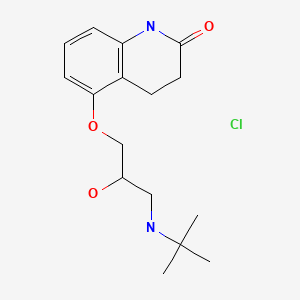Attribution Statement: LactMed is a registered trademark of the U.S. Department of Health and Human Services.
NCBI Bookshelf. A service of the National Library of Medicine, National Institutes of Health.
Drugs and Lactation Database (LactMed®) [Internet]. Bethesda (MD): National Institute of Child Health and Human Development; 2006-.
CASRN: 51781-21-6

Drug Levels and Effects
Summary of Use during Lactation
No data are available for the use of carteolol during breastfeeding. Because its excretion into breastmilk is probably extensive, other beta-adrenergic blocking drugs are preferred to oral carteolol while breastfeeding a neonate. Infants over 2 months of age have more mature kidney function and are less likely to be affected.
Ophthalmic use of carteolol by the mother should pose little risk to the breastfed infant, although some guidelines state that gel formulations are preferred over solutions.[1,2] substantially diminish the amount of drug that reaches the breastmilk after using eye drops, place pressure over the tear duct by the corner of the eye for 1 minute or more, then remove the excess solution with an absorbent tissue.
Drug Levels
The excretion of beta-adrenergic blocking drugs into breastmilk is largely determined by their protein binding. Those with low binding are more extensively excreted into breastmilk.[3] Accumulation of the drugs in the infant is related to the fraction excreted in urine. With 60% protein binding, 15% renal excretion and a moderately long half-life, carteolol presents a relatively high risk for accumulation in infants, especially neonates.
Maternal Levels. Relevant published information was not found as of the revision date.
Infant Levels. Relevant published information was not found as of the revision date.
Effects in Breastfed Infants
A study of mothers taking beta-blockers during nursing found a numerically, but not statistically significant increased number of adverse reactions in those taking any beta-blocker. Although the ages of infants were matched to control infants, the ages of the affected infants were not stated. None of the mothers were taking carteolol.[4] Beta-adrenergic blocking drugs with similar breastmilk excretion characteristics have caused adverse effects in breastfed newborns.[5,6]
Effects on Lactation and Breastmilk
A study in 6 patients with hyperprolactinemia and galactorrhea found no changes in serum prolactin levels following beta-adrenergic blockade with propranolol.[7] There are no reports on the effects of beta-blockade or carteolol use during normal lactation.
Alternate Drugs to Consider
(Systemic) Propranolol, Labetalol, Metoprolol; (Ophthalmic) Levobunolol, Metipranolol, Timolol
References
- 1.
- Belkin A, Chen T, DeOliveria AR, et al. A practical guide to the pregnant and breastfeeding patient with glaucoma. Ophthalmol Glaucoma. 2020;3:79–89. [PubMed: 32672600]
- 2.
- Blumen-Ohana E, Sellem E. J Fr Ophtalmol. 2020;43:63–6. [Pregnancy & glaucoma: SFO-SFG recommendations] [PubMed: 31813552]
- 3.
- Riant P, Urien S, Albengres E, et al. High plasma protein binding as a parameter in the selection of betablockers for lactating women. Biochem Pharmacol. 1986;35:4579–81. [PubMed: 2878668]
- 4.
- Ho TK, Moretti ME, Schaeffer JK, et al. Maternal beta-blocker usage and breast feeding in the neonate. Pediatr Res. 1999;45(4, pt. 2):67A–Abstract 385. [CrossRef]
- 5.
- Boutroy MJ, Bianchetti G, Dubruc C, et al. To nurse when receiving acebutolol: Is it dangerous for the neonate? Eur J Clin Pharmacol. 1986;30:737–9. [PubMed: 3770068]
- 6.
- Schimmel MS, Eidelman AI, Wilschanski MA, et al. Toxic effects of atenolol consumed during breast feeding. J Pediatr. 1989;114:476–8. [PubMed: 2921694]
- 7.
- Board JA, Fierro RJ, Wasserman AJ, et al. Effects of alpha- and beta-adrenergic blocking agents on serum prolactin levels in women with hyperprolactinemia and galactorrhea. Am J Obstet Gynecol. 1977;127:285–7. [PubMed: 556882]
Substance Identification
Substance Name
Carteolol
CAS Registry Number
51781-21-6
Disclaimer: Information presented in this database is not meant as a substitute for professional judgment. You should consult your healthcare provider for breastfeeding advice related to your particular situation. The U.S. government does not warrant or assume any liability or responsibility for the accuracy or completeness of the information on this Site.
- User and Medical Advice Disclaimer
- Drugs and Lactation Database (LactMed) - Record Format
- LactMed - Database Creation and Peer Review Process
- Fact Sheet. Drugs and Lactation Database (LactMed)
- Drugs and Lactation Database (LactMed) - Glossary
- LactMed Selected References
- Drugs and Lactation Database (LactMed) - About Dietary Supplements
- Breastfeeding Links
- PubChem SubstanceRelated PubChem Substances
- PubMedLinks to PubMed
- Review Timolol.[Drugs and Lactation Database (...]Review Timolol.. Drugs and Lactation Database (LactMed®). 2006
- [Pharmaceutical chemical and analytical data for the pharmaceutically-active substance carteolol hydrochloride].[Arzneimittelforschung. 1983][Pharmaceutical chemical and analytical data for the pharmaceutically-active substance carteolol hydrochloride].Winkler W. Arzneimittelforschung. 1983; 33(2a):279-80.
- Review Nadolol.[Drugs and Lactation Database (...]Review Nadolol.. Drugs and Lactation Database (LactMed®). 2006
- Review Levobunolol.[Drugs and Lactation Database (...]Review Levobunolol.. Drugs and Lactation Database (LactMed®). 2006
- Review Metipranolol.[Drugs and Lactation Database (...]Review Metipranolol.. Drugs and Lactation Database (LactMed®). 2006
- Carteolol - Drugs and Lactation Database (LactMed®)Carteolol - Drugs and Lactation Database (LactMed®)
Your browsing activity is empty.
Activity recording is turned off.
See more...
